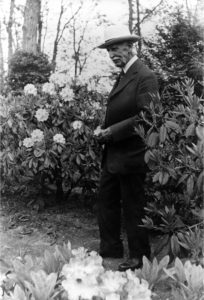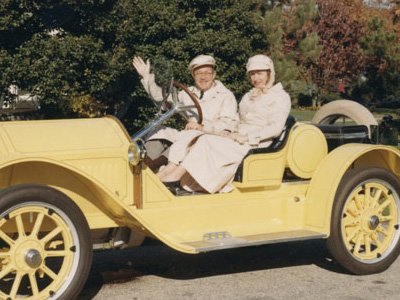Heritage History
The First Residents
The Wampanoag residents of the land that is now Heritage Museums & Gardens used the large lawn area adjacent to the Special Exhibitions Gallery as a summer garden location. Wing family records describe this area as Native planting fields with a small structure for the women who tended the garden. When Heritage was being constructed between 1967 and 1969, the topsoil on this lawn was removed, revealing ancient hearth rings and Wampanoag artifacts. Heritage has a small collection of Wampanoag stone tools found on this land including arrowheads, a grindstone and an adze.
 The Wing Family
The Wing Family
A young mother, recently windowed, was the first person of European descent to live on the land that became Heritage. Lydia Wing (1647-after 1704) grew up in Sandwich, then married and moved to Rhode Island. Following her husband’s death, she returned to town with her young two sons. Instead of moving in with family members, as would have been customary at the time, she moved with her boys into the Wampanoag garden shelter.
The Wings were a Quaker family, and we can establish facts about Lydia’s life through the minutes of the Quaker men’s and women’s monthly meeting groups. Lydia and her sons were living in real poverty, and the Quakers provided her with clothing, food, medical care, and cash. Doubtless, her Wing relatives also provided labor and supplies regularly.
Lydia married John Abbott in 1686. In 1688 Sandwich gave the Abbotts the three acres they were using as their farm. Soon thereafter, grants of land were made nearby to Lydia’s brother, Daniel Wing, Jr. who built the house which serves as Heritage’s administration building.
Over the next two centuries, the Wing family prospered in the Heritage area with descendants living in three nearby houses. At present much of the old Wing family farm remains part of the current grounds. Although members of the Wing family have not lived on the property since the mid-1800s, their legacy remains a vital part of the history of Heritage.
Frank Edwin Elwell
The sculptor Frank Edwin Elwell (1858-1922) purchased the former Wing family farm in 1885 as a second home. Born in Concord, Massachusetts, he grew close to author Louisa May Alcott as a child. He showed promise as an artist early in life, and his first art teacher was Louisa’s sister Abigail May Alcott. Elwell continued his art education at the Museum of Fine Arts, Boston. With the aid of Louisa May Alcott and sculptor Daniel Chester French, he was sent to Paris to study art in 1881. From 1903-to 1905 Elwell was Curator of Ancient and Modern Statuary at the Metropolitan Museum of Art in New York City.
After purchasing the Wing farm, he turned a poultry house into an art studio where he created the first model for his most famous sculpture, Little Nell, in 1891. Perhaps his most lasting legacy for the town of Sandwich is the annual illuminated boat parade held during the July 4 celebrations. He began the tradition after witnessing similar boat parades in Venice.
 John Josiah Crane
John Josiah Crane
John Crane (1866-1926) spent his working career as a stockbroker in New York City. He retired at age 34 to Sandwich, purchased the property from Elwell in 1900, and became a cranberry farmer. His bogs were located behind the Wing family house, adjacent to Upper Shawme Pond. In an interesting prelude, Crane built a windmill to pump water into and out of the bogs, preceding the move of the Old East Mill from Orleans to this site fifty years later. Crane was a serious student of astronomy and built an observation tower for his telescope near where the Old East Mill now stands. He is pictured here with his wife Annie.
Charles O. Dexter
New Bedford textile manufacturer Charles Owen Dexter (1862-1943) purchased the property from the Cranes in 1921 and renamed it Shawme Farm. Dexter was 59 years old and had just been told he had a bad heart and could not expect a long life. He wanted to indulge his interest in horticulture in his remaining years, and Shawme Farm provided the perfect place for his horticultural endeavors.
Dexter ended up living for another 22 years, providing plenty of time to experiment with plants. He began by planting fruit and vegetables, but soon moved on to hybridizing rhododendrons, the work he is most remembered for today. With his chief gardener, Antonio Consolini, Dexter produced at least 150,000 to 200,000 hybrid rhododendron seedlings, many planted in the woodlands surrounding Upper Shawme Pond. His goal was to breed plants that were both cold-hardy and had large blooms. He succeeded in this goal and is remembered today for many unique and colorful varieties of rhododendrons that are still being enjoyed in the Heritage gardens today.
The Lilly Family – Founders of Heritage Museums & Gardens
After Charles Dexter’s death, the property changed hands four times before being purchased by Mr. and Mrs. Josiah K. Lilly III in 1967 as a location for their new museum. The Lilly’s had begun collecting antique automobiles in 1964, and their collection grew rapidly. In 1966 after Mr. Lilly’s father died, they acquired from his estate his military and art collections. With these items in addition to their antique cars, they began to consider opening their own museum. They considered a few properties on Cape Cod but chose this one for its varied terrain and Dexter’s rhododendron plantings.

Construction of new museum buildings and a renovation of the gardens proceeded quickly, and Heritage Plantation of Sandwich opened to the public on June 15, 1969. Heritage at that time consisted of an antique automobile museum and a military museum, as well as the Old East Mill and extensive gardens. Plans quickly materialized for the addition of the Arts and Crafts Museum which opened in 1972, with a centerpiece of a working 1908 carousel.
Heritage Museums & Gardens has continued to evolve over its more than 50 years in operation, adding many new museum collections and garden features. In 2014 Heritage opened The Hundred Acre School, a STEM-based school for students from preschool through first grade. Currently Heritage welcomes over 100,000 visitors per year, and in 2021 surpassed over 5 million cumulative visitors since opening in 1969.




